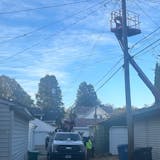On a recent Friday, Isaiah Etienne, 19, was at the Apple store at a mall in the Philadelphia suburb of Cherry Hill, N.J.
He used to hit the shoe and clothing stores weekly. But that changed after he turned 18.
"I've definitely slowed down on the clothes and sneaker shopping," Etienne said. Instead, a chunk of his cash now goes to electronics.
The scene that day helps explain why once dominant teen retailers — such as Aeropostale, American Eagle Outfitters and Abercrombie & Fitch — are closing stores. A 2015 Retail Real Estate Report by consultant DTZ projects Aeropostale closing 175 stores through 2017; American Eagle, 150; and Abercrombie, 170.
All three stores sat virtually empty from 4:30 to 6:30 p.m. that Friday at Cherry Hill Mall.
"Teen retailers are in a high-risk, high-reward business — a trendy fashion appeal with a fickle customer base," said New York retail consultant Howard Davidowitz. "The decline is a long-term trend."
Industry experts cited four reasons:
Competition. "Fast-fashion" retailers (those with quick turnaround that buy in bulk and sell cheaply) now dominate. Examples include Forever 21 and H&M.


